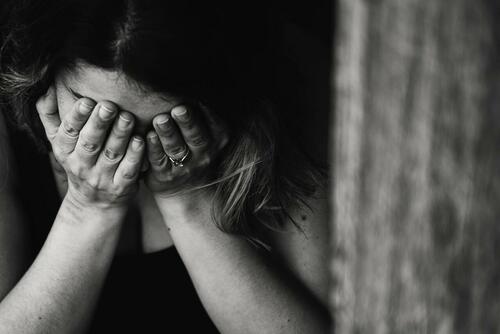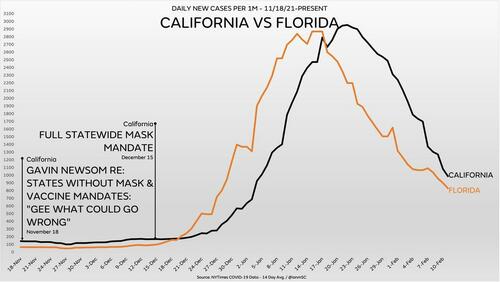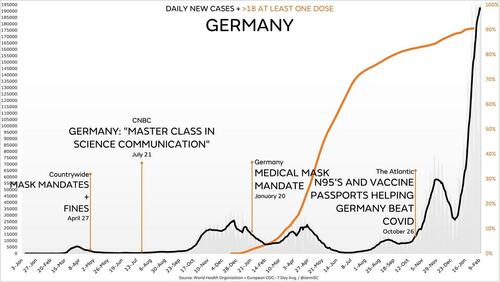“Pandora’s Box Of Harms”: How Public Health Erred On Side Of Catastrophe
Authored by Brian McGlinchey via Stark Realities,
Throughout the Covid-19 pandemic, proponents of lockdowns, shelter-in-place orders, mask mandates and other coercive government interventions have characterized these measures as benevolently “erring on the side of caution.” Now, as the grim toll of those public health measures comes into ever-sharper focus, it’s increasingly clear those characterizations were terribly wrong.
What’s less readily apparent, however, is how the very use of the “erring on the side of caution” framing was injurious in itself—by thwarting reasoned debate of public health policies, diverting attention from unintended consequences, and buffering the Covid regime’s architects from accountability.
To understand how the misuse of “erring on the side of caution” performed a sort of mass hypnosis that coaxed populations into two years of submission to disastrous, overreaching policies, consider how the expression is typically used.
In everyday life, one might err on the side of caution by:
- Leaving for the airport an extra 30 minutes early
- Carrying an umbrella when there’s a 25% chance of rain
- Opting for a less-challenging ski slope
- Going back into the house to make sure the iron is unplugged
- Getting a second medical opinion
Generally speaking, “erring on the side of caution” in everyday life means lowering risk with a precaution that has a negligible cost.
When mandate proponents portrayed their edicts as “erring on the side of caution,” it had the effect of tacitly assuring the public—and themselves—that there’d be little or no harm associated with extreme measures like:
- Shutting down businesses for months at a time
- Knowingly forcing millions of people into unemployment
- Halting in-person attendance at schools and colleges
- Ordering people of all ages and risk profiles to wear masks
- Denying people opportunities to socialize, recreate and enjoy living
That implicit low-downside assurance not only fostered unthinking support for draconian measures among citizens and experts alike, it also cultivated an atmosphere of intolerance toward those who questioned the wisdom of these interventions and predicted the great many harms that have resulted.
“Overconfident, unnuanced messaging conditioned us to assume that all dissenting opinions are misinformation rather than reflections of good faith disagreement or differing priorities,” write Rutgers professors Jacob Hale Russell and Dennis Patterson in their essay, The Mask Debacle. “In doing so, elites drove out scientific research that might have separated valuable interventions from the less valuable.”
Of course, in addition to its implicit assurance that a risk-reduction measure comes at little cost, “erring on the side of caution” conveys an assumption that the precaution will actually be effective.
That hasn’t been the case with Covid mandates. Though many continue embracing the illusion of government control over Covid, the contrary studies and real-world observations are stacking far too high to be denied any longer by the intellectually honest among us.
Charts via Ian Miller at Unmasked
Public Health Threw Out the Playbook and Threw Pandora’s Box Wide Open
The masses who’ve chanted “I trust science,” as they praise each government intervention and idolize those who impose them, are likely unaware that, before Covid-19, the well-considered scientific consensus was against lockdowns, broad quarantines and masking outside of hospital settings—particular for a virus like Covid-19 that has a 99% survival rate for most age groups.
For example, a 2006 paper published by the Center for Biosecurity of the University of Pittsburgh Medical Center—focusing on mitigation measures against another contagious respiratory illness, pandemic influenza—reads like a warning label against many of the policies inflicted on humanity in the face of Covid-19:
-
“There is no basis for recommending quarantine either of groups or individuals. The problems in implementing such measures are formidable, and secondary effects of absenteeism and community disruption as well as possible adverse consequences…are likely to be considerable.”
-
“Widespread closures [of schools, restaurants, churches, recreations centers, etc] would almost certainly have serious adverse social and economic effects.”
-
“The ordinary surgical mask does little to prevent inhalation of small droplets bearing influenza virus…There are few data available to support the efficacy of N95 or surgical masks outside a healthcare setting. N95 masks need to be fit-tested to be efficacious.”
The point of that and other pre-2020 research into pandemic mitigation was to be prepared, in times of crisis, with policies that reflected a well-reasoned and dispassionate weighing of costs and benefits.
However, when the pandemic arrived, panicking public health officials and academics threw out the playbook and took their policy inspiration from the government that was first to confront the virus. Sadly for the world, that was communist China.
The breadth of the resulting harms from the ensuing plunge into public health authoritarianism is staggering. Far from erring on the side of caution…
Public health erred on the side of a mental health crisis. Anxiety and depression have surged, particularly among adolescents and young adults, where symptoms have doubled during the pandemic.
“I have never been as busy in my life and I’ve never seen my colleagues as busy,” New York psychiatrist Valentine Raiteri told CNBC. “I can’t refer people to other people because everybody is full.”
Public health erred on the side of juvenile suicide attempts. In the summer of 2020, emergency room visits for potential suicides by children leapt over 22% compared to the summer of 2019.
Public health erred on the side of drug overdoses. According to the National Institute on Drug Abuse, overdose deaths surged 30% in 2020 to a record-high of more than 93,000. Among the factors cited: social isolation, people using drugs alone, and decreased access to treatment.
Public health erred on the side of auto fatalities. Traffic deaths had been on a general downtrend since the 60s, reaching a near-record low in 2019. However, even with shutdown-lightened traffic, deaths jumped 17.5% in the summer of 2020 compared to 2019, and kept rising into 2021.
Blame increased drug and alcohol use, along with psychological fallout from people being denied life’s fundamental pleasures. University of Texas cognitive scientist Art Markman told The New York Times that anger and aggression behind the wheel in part reflects “two years of having to stop ourselves from doing things that we’d like to do.”
Public health erred on the side of domestic violence. A review of 32 studies found an increase in domestic violence around the world, with the increases most intense during the first week of lockdowns. “The home confinement led to constant contact between perpetrators and victims, resulting in increased violence and decreased reports,” the researchers found.
Public health erred on the side of riots, arson and looting. It’s my own conviction that 2020’s eruption of summer violence following a Minneapolis police officer’s callous homicide of George Floyd was greatly magnified by the period of forced mass confinement that preceded it.
Floyd’s death was a match dropped into a tinderbox of humanity confined to veritable house arrest. People blocked from restaurants and bars were suddenly granted a societal waiver to venture out into enormous crowds, where they found excitement, socialization and, far too often, a senselessly destructive means of venting months of pent-up energy, anxiety and frustration. It stands as the costliest civil unrest episode in American history.
Public health erred on the side of confining people where the virus is transmitted most. Lockdowns ordered people away from workplaces, schools, restaurants and bars and into their homes, where New York contract tracers found 74% of Covid spread was happening, compared to just 1.4% in bars and restaurants and even less in schools and workplaces.
Public health erred on the side of obesity. According to the CDC, “the risk of severe COVID-19 illness increases sharply with higher BMI [Body Mass Index].” So what happens when public health “experts” shut down schools, workplaces and recreation options and told people to stay home to stay “safe”?
The CDC found that, in 2020, the rate by which BMI increased among 2- to 19-year olds doubled. Another study found that 48% of adults gained weight during the pandemic, with those who were already overweight most likely to add even more. Among other factors, the study pointed to psychological distress and having schoolchildren at home.
Public health erred against fresh air, exercise and Vitamin D. Governments raced to shut down playgrounds, basketball courts and other outdoor recreation facilities. In a move that’s profoundly emblematic of heavy-handed, counterproductive authoritarianism in the age of Covid, the city of San Clemente, California filled a skate park with 37 tons of sand.
Public health erred on the side of impaired child development. “We find that children born during the pandemic have significantly reduced verbal, motor, and overall cognitive performance compared to children born pre-pandemic,” say the authors of a study from Paediatric Emergency Research in the UK and Ireland (PERUKI).
“Results highlight that even in the absence of direct SARS-CoV-2 infection and COVID-19 illness, the environmental changes associated [with the] COVID-19 pandemic [are] significantly and negatively affecting infant and child development.”
Public health erred on the side of learning loss. Children are less vulnerable to Covid-19 than they are to the flu, and rarely transmit it to teachers. Unfortunately, American public health officials and teacher unions prevailed in halting in-person instruction (and socialization) in favor of “remote learning.”
It was a poor substitute that fell hardest on the youngest learners. For example, according to curriculum and assessment provider Amplify, the percentage of first-graders scoring at or above the goals for their grade in mid-school-year dropped from 58% before the pandemic to just 44% this year.
Public health erred on the side of pointlessly masking schoolchildren. When schools did open, mask mandates abounded—despite children’s relative invulnerability to the virus and the documented rarity of in-school transmission. A Spanish study showed no discernible difference in transmission among 5-year-olds—who aren’t required to mask—and 6 year olds, who are.
“Masking is a psychological stressor for children and disrupts learning. Covering the lower half of the face of both teacher and pupil reduces the ability to communicate,” wrote Neeraj Sood, director of the Covid Initiative at USC, and Jay Bhattacharya, professor of medicine at Stanford. “Positive emotions such as laughing and smiling become less recognizable, and negative emotions get amplified. Bonding between teachers and students takes a hit.”
“Most of the masks worn by most kids for most of the pandemic have likely done nothing to change the velocity or trajectory of the virus,” writes University of California associate professor of epidemiology and biostatistics Vinay Prasad. “The loss to children remains difficult to capture in hard data, but will likely become clear in the years to come.”
Public health erred on the side of giving masked people a false sense of security. As I wrote in August, “Covid-19 particles are astoundingly small. Hard as it is to imagine, the imperceptible gaps in surgical masks can be 1,000 times the size of a viral particle. Gaps in cloth masks are well larger.” That’s to say nothing of the respirated air that simply goes around the mask’s edges.
Earlier in the pandemic, questioning cloth masks triggered outrage and swift social media censorship. Now, even mandate-happy CNN medical analyst Leanna Wen has declared they’re “little more than facial decorations.” Mask skepticism is sprouting elsewhere in mainstream media; the Washington Post and Bloomberg even published an essay titled “Mask Mandates Didn’t Make Much of a Difference Anyway.”
Chart via Ian Miller at Unmasked
When public health officials exaggerated the power of masks, they did more than promote pointless discomfort and a dystopian way of life. “Naively fooled to think that masks would protect them, some older high-risk people did not socially distance properly, and some died from Covid-19 because of it,” said epidemiologist, biostatistician and former Harvard Medical School professor Martin Kulldorff.
Public health erred on the side of killing small businesses. Thanks in large part to government’s targeting of so-called “non-essential businesses,” the first year of the pandemic brought an additional 200,000 business closures over prior levels.
Public health erred on the side of harming women’s careers. Women comprise a greater proportion of the sectors hid hardest by lockdowns, and the closing of schools and child care centers prompted many more women than men to put their careers on hold.
Public health erred on the side of inflation. To offset the massive economic destruction inflicted by public health shutdowns, the federal government plunged into an astounding spending spree, handing out cash to individuals, businesses and city and state governments.
It was money the government didn’t have, so the Federal Reserve essentially created it out of thin air. Pushing all that new fiat money into circulation debases the currency, fueling today’s surging price inflation—which is a stealth tax with no maximum rate, which hits poor people hardest.
Note: Lockdowns and other mandates weren’t the exclusive driver of many of the various harms I’ve described; general fear of the virus also contributed to some of them. However, it should also be noted that public health officials—and media that overwhelmingly emphasized negative stories—whipped up a level of fear that led people to overstate the level of danger actually posed by the virus.
There’s one more way in which characterizing lockdowns and other mandates as “erring on the side of caution” plays a psychological trick: Since the phrase is embedded with the notion of good intentions, it conditions citizens to be forgiving of the bureaucrats and politicians who imposed them.
Note, however, that in most everyday usage of “erring on the side of caution,” the choice to “err” is made voluntarily by individuals who bear the consequences of their own decisions—or by others, like an airplane pilot or a surgeon, to whom we’ve voluntarily and unmistakably granted control of our well-being.
The grim impacts of lockdowns and other mandates, however, were coercively imposed on society, to say nothing of the fact that so many of the edicts represented gross usurpations of power and violations of human rights.
On top of all that, the edicts were reinforced by Orwellian censorship and ostracism leveled at those who dared raise questions that have now proven valid.
So make no mistake: Overreaching public health officials and politicians—and the journalists-in-name-only who served as their mindless, unquestioning megaphones—have fully earned our withering condemnation. Indeed, holding them accountable is essential to sparing ourselves and future generations from repeating this dystopian chapter of human history.
* * *
Stark Realities undermines official narratives, demolishes conventional wisdom and exposes fundamental myths across the political spectrum. Read more and subscribe at starkrealities.substack.com
Tyler Durden
Mon, 02/28/2022 – 19:00
via ZeroHedge News https://ift.tt/ABCWs26 Tyler Durden



